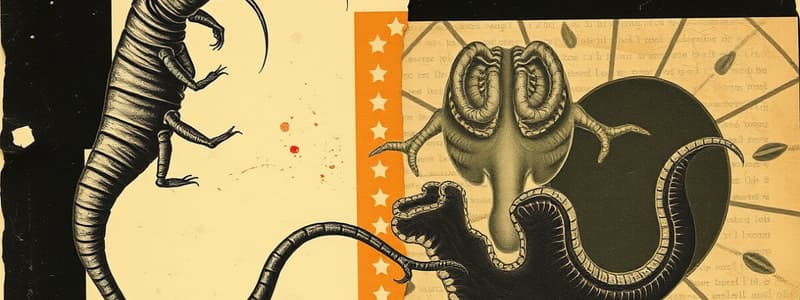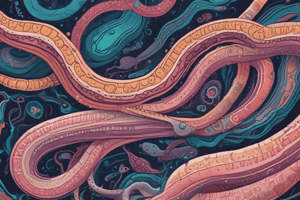Podcast
Questions and Answers
Which characteristic is NOT associated with the reproductive process of nematodes?
Which characteristic is NOT associated with the reproductive process of nematodes?
- Internal fertilization occurs.
- They can reproduce asexually. (correct)
- Some species are hermaphroditic.
- Reproduction can be dioecious.
What feature differentiates trematodes from nematodes regarding their body structure?
What feature differentiates trematodes from nematodes regarding their body structure?
- Presence of dorsal and ventral nerve cords.
- Possession of a true body cavity.
- Flattened, leaf-like body shape. (correct)
- Segmentation of the body.
What role do the amphids serve in roundworms?
What role do the amphids serve in roundworms?
- Facilitation of digestion.
- Attachment to hosts for feeding.
- Detection of chemical stimuli. (correct)
- Protection against predators.
Which of the following statements about the digestive system of trematodes is true?
Which of the following statements about the digestive system of trematodes is true?
What type of habitats can nematodes be found in?
What type of habitats can nematodes be found in?
Which of the following parasitic diseases is caused by trematodes?
Which of the following parasitic diseases is caused by trematodes?
What is a common life cycle characteristic of trematodes?
What is a common life cycle characteristic of trematodes?
What anatomical feature aids trematodes in attaching to their hosts?
What anatomical feature aids trematodes in attaching to their hosts?
Which of the following is false regarding roundworm feeding habits?
Which of the following is false regarding roundworm feeding habits?
What method do roundworms use to develop and grow?
What method do roundworms use to develop and grow?
What is the primary function of flame cells in the excretory system of flukes?
What is the primary function of flame cells in the excretory system of flukes?
Which of the following diseases is not caused by flukes?
Which of the following diseases is not caused by flukes?
In cestodes, what is the function of the scolex?
In cestodes, what is the function of the scolex?
How do cestodes obtain nutrients from their host?
How do cestodes obtain nutrients from their host?
Which part of the cestode's body structure is responsible for containing the reproductive organs?
Which part of the cestode's body structure is responsible for containing the reproductive organs?
What role do intermediate hosts play in the life cycle of cestodes?
What role do intermediate hosts play in the life cycle of cestodes?
Which of the following statements about the reproductive system of cestodes is true?
Which of the following statements about the reproductive system of cestodes is true?
What is a common method for preventing diseases caused by flukes?
What is a common method for preventing diseases caused by flukes?
What characteristic is unique to the body structure of cestodes?
What characteristic is unique to the body structure of cestodes?
Which feature distinguishes the tegument of cestodes?
Which feature distinguishes the tegument of cestodes?
Which characteristic is unique to nematodes compared to platyhelminths?
Which characteristic is unique to nematodes compared to platyhelminths?
What type of infectious route is associated with the ingestion of eggs or larvae for helminths?
What type of infectious route is associated with the ingestion of eggs or larvae for helminths?
Which feature is common in both trematodes and cestodes under the classification of platyhelminths?
Which feature is common in both trematodes and cestodes under the classification of platyhelminths?
Which of the following statements is true regarding the body structure of nematodes?
Which of the following statements is true regarding the body structure of nematodes?
What environmental factor is most likely to influence helminth infection rates?
What environmental factor is most likely to influence helminth infection rates?
Which of the following helminths is classified as a nematode?
Which of the following helminths is classified as a nematode?
Which characteristic is not typical of helminths?
Which characteristic is not typical of helminths?
What distinguishes hermaphroditic helminths from those with separate sexes?
What distinguishes hermaphroditic helminths from those with separate sexes?
What role do vectors play in the life cycle of some helminths?
What role do vectors play in the life cycle of some helminths?
What type of digestive system do nematodes possess?
What type of digestive system do nematodes possess?
Study Notes
Helminths Overview
- Helminths refer to parasitic worms, encompassing Platyhelminthes (flatworms) and Nematoda (roundworms).
- Characterized by size greater than 1 mm; some species can exceed 1 m in length.
- Exhibit well-developed organ systems and active feeding mechanisms.
- Body morphology includes flattened plasma membranes in flatworms and cylindrical cuticles in roundworms.
- Reproductive strategies include hermaphroditism and separate sexes.
Transmission Routes
- Ingestion: Eggs or larvae from contaminated food/water (e.g., Ascaris, Echinococcus).
- Penetration: Larvae invading skin (e.g., hookworms).
- Vectors: Transmission by biting arthropods (e.g., filarial worms).
- Intermediate Hosts: Consumption of infected meat, fish, or intermediate hosts (e.g., Clonorchis, tapeworms).
Factors Influencing Infections
- Climate, hygiene practices, dietary habits, and vector exposure significantly contribute to infection rates.
- High prevalence observed in underdeveloped countries.
Classification of Helminths
- Divided into two primary categories: Nematodes (roundworms) and Platyhelminths (flatworms).
- Platyhelminths further classified into Trematodes (flukes) and Cestodes (tapeworms).
Nematodes (Roundworms)
- Exhibit cylindrical body shape with bilateral symmetry.
- Possess a pseudocoelom, facilitating bodily functions and a complete digestive system with mouth and anus.
- Nervous system consists of dorsal and ventral nerve cords; amphids present for chemosensory functions.
- Found in diverse habitats: soil, freshwater, marine; free-living species feed on microorganisms, while parasitic forms infect animals and plants.
- Diocious or hermaphroditic reproductive systems; internal fertilization leads to periodic cuticle molting.
- Diseases such as ascariasis, hookworm infections, and filariasis significantly affect human and animal health.
Trematodes (Flukes)
- Characterized by flattened, oval, or leaf-like body shape; acoelomate structure.
- Possess suckers for host attachment, including oral and ventral suckers.
- Complete digestive system with mouth and esophagus; lacks anus, waste expelled via mouth.
- Typically hermaphroditic, with complex life cycles involving multiple hosts.
- Excretory system features flame cells; nervous system includes paired ganglia and ventral nerve cords.
- Associated with diseases like schistosomiasis and fascioliasis; preventive measures focus on sanitation and snail population control.
Cestodes (Tapeworms)
- Flattened, ribbon-like body divided into segments (proglottids), each containing reproductive organs.
- Scolex, the anterior end, serves as the attachment organ; lacks mouth and digestive system.
- Nutrient absorption occurs directly from the host's intestine through the specialized tegument.
- Reproductive system is hermaphroditic; fertilized eggs are released from gravid proglottids.
- Lifecycle commonly includes intermediate hosts for larval development, with adult worms residing in definitive vertebrate hosts.
Studying That Suits You
Use AI to generate personalized quizzes and flashcards to suit your learning preferences.
Related Documents
Description
Explore the fascinating world of helminths, including flatworms and roundworms. This quiz covers their structure, classification, growth, and development, revealing the complexities of these parasitic organisms. Test your knowledge on their general characteristics and life cycles.




